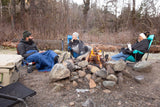Trail Essentials: Everything You Need to Know About Trekking Poles

(Words by Sarah Bauchner, Photos by Frank Colorado and Dillon Crippen)
The better you care for it, the longer you can use it. And we're not talking about trekking poles, we’re talking about our bodies. Whether you're interested in purchasing a pair of trekking poles to reduce strain on knees during descents or for improving balance when walking across rough terrain, choosing the suitable trekking poles for the job can help make your outdoor experience more comfortable.
Spending time on the trail can often lead to sore joints and increased pain over time. Trekking poles were made to help alleviate some of this pressure on your body so that you can spend more time doing what you love. You don't have to be an avid thru-hiker or suffering from a knee injury to enjoy the benefits of trekking poles.
We have created a complete guide to trekking poles and how to use them on your hiking adventures. We invite you to read on for valuable information on pole construction, tip covers, baskets, wrist straps, and ways to adjust them to the right height. We hope this resource will answer your questions - and you'll be ready to hit the trail.
Why Use Trekking Poles?
Trekking poles provide added stability when traversing rugged terrain. They also make long and frequent hiking more enjoyable by reducing the impact of uphill and downhill on your joints. In addition, when trying to cover more ground in a shorter time frame, they can help propel you forward with more ease. Finally, keeping them adjusted to the correct height can help improve your posture on the trail by keeping your body more upright.

The Basics.
So, what sets one pair of trekking poles apart from another? How do you know what to buy? Several main characteristics differentiate trekking poles, and these are the seven things you need to look for: grips, straps, materials, structure, locking mechanism, baskets, and tips.
1. Grips
Almost entirely a matter of the environments you hike in and your comfort preferences, trekking poles are engineered with a variety of different grips with different needs in mind. Cork, rubber, and foam are three of the most common materials you'll encounter when looking at grips.
- Cork is a hiker's favorite because they break into the shape of your hands with extended use. They are more relaxed than rubber grips and provide some absorbency if your hands get sweaty or the grips get wet.
- EVA (Rubber) is a favorite for cold-weather hikers. However, because rubber grips don't absorb any water or sweat, you may get too much slippage if you're hiking in hot weather. Alas, some hikers find them more comfortable to grip for extended periods than cork.
- Foam is a light and affordable option. In addition to comfort, foam grips absorb water, so wet climate hikers might enjoy these more than rubber or cork grips.
2. Straps
When it comes to straps, be sure you're choosing a long-lasting woven material. If you worry about rubbing on the wrist, try wearing a wrist band or gloves to deter chafing. However, the material you choose is more of a preference in what feels comfortable to you. The most important thing to note about straps is how you use them. It is far too common to see straps used in a way that is counterproductive to the hike. To use them correctly, put your hand upwards through the underside of the strap and then grab the grip. This will help the pole stay on your wrist while allowing your hand to relax into the grip. You can then size the strap using the wedge, allowing you to release the pole, get into your pack, or take a picture without setting it down.

3. Materials
In most cases, Trekking poles are manufactured of aluminum or carbon.
Carbon fiber is lightweight, stiffer, and generally sturdier, but if the poles take a hit or get caught in something on the trail, a section could see some damage. The Cascade Mountain Tech carbon fiber poles range in weight from 11.2 ounces to 16 ounces per set. Compared to aluminum, which is 20.8 ounces, it is a better choice for those who wish to pack ultra-light and focus on speed. In addition, the lack of flexing from the carbon fiber allows for immediate support when the pole hits a surface. Cascade Mountain Tech offers three options for carbon fiber trekking poles: our original, the 3K Carbon fiber pole, and our newest ultralight carbon fiber trekking pole.
Aluminum is somewhat heavier, generally having a longer lifespan. Aluminum poles are not as temperature-sensitive and perform equally well in the blazing heat and the frigid cold. Small bends in the aluminum poles can usually be repaired, leaving the poles in good condition. In addition, aluminum poles are generally less expensive than carbon fiber poles. So, if you are shopping for a highly durable, more affordable pole, aluminum trekking poles might be the right option for you.
In the end, aluminum is the more durable and economical option, but if you are serious about weight, carbon is the material you'll find most appealing.
Click here for a more in-depth look at the materials.
4. Structure
Telescoping poles - Not only are telescoping poles easily adjustable, but their tried-and-true construction has rightfully made them a trail favorite. Most telescoping poles come with two or three sections. What you choose depends on where you will be taking them. The more sturdy of the two is the two-sectioned poles; they are more durable and work great on long strenuous hikes with lots of heavy use. The only real downside to these poles is that they aren't as packable as the three-section poles or folding poles. But, if you are tough on your gear or need something that can withstand many impacts, these are the poles for you.
The Three-section poles are also very popular among avid hikers. They are super packable and can be carried on just about any daypack and even in a carry-on suitcase if you have plans for an international hike. What they lack in durability, compared to the two-section poles, they make up for with their easy-to-store construction.
Folding Poles - The more recently developed Folding Poles are a lightweight and highly packable alternative to the Telescopic Poles. Honestly, when you first see them, you might think they look like a tent pole, and that's because they use a very similar design with a shock cord linking the shafts. However, unlike some folding poles on the market, Cascade Mountain Tech's folding poles can be easily adjusted between 44 and 54 inches. As such, the poles are perfect whether you are tall, short, or anywhere in between.

5. Locking Mechanism
The trekking pole needs to be solid; it's kind of the point. That's where the locking mechanism comes in. There are two main types of mechanisms: The Quick-Lock (external lock) and the Twist-Lock (internal lock). These locking mechanisms are also used to adjust the length of each interlocking section, allowing you to adapt the poles to your height and the terrain you will be crossing.
Cascade Mountain Tech poles have two different locking mechanisms to choose from.
Quick-Lock: A lever-based clamp mechanism that makes pole length quick to adjust. This is a popular choice because, even while wearing gloves, you can modify them to fit your next move on the trail with ease.
Twist Lock: A sturdy option, the Twist Lock uses an expander and screw setup that might not be as fast to adjust, but it is loved for its durability and is the lighter-weight option.
6. Baskets
In addition to the Rubber Boot Tips and the small tips, all Cascade Mountain Tech trekking poles come with snow and mud baskets. These are helpful in deep snow or mud but are not necessary for general hiking and will only increase the weight of your poles. The snow baskets are for use when walking in snow or when you are snowshoeing. You should never use your trekking poles for skiing, either alpine or Nordic.

7. Tips
The majority of poles will come stock with a carbide steel tip. The option is yours whether or not you want to add rubber tips or not. Rubber tips show their worth when hiking on solid surfaces like cement and rock, but they struggle on wet surfaces, and they don't give an excellent grip when traveling on loose dirt. And though Carbide tips skid more quickly on hard surfaces, they do fantastic on most others. The rubber tip that comes with your purchase of Cascade Mountain Tech poles can be used on fragile terrain or to protect floor surfaces, as many historic sites require them anyways. The poles also come with a rubber boot tip that provides added stability for extended downhill hiking and crossing large boulders.
Using and Adjusting Your Trekking Poles
Though pole height is mostly a preference, you still need to consider what your body needs. All of Cascade Mountain Tech's trekking poles are height adjustable. Before you start your journey, be sure to adjust the pole height by extending or shortening. Using the inch/centimeter markers on your poles for help, bend your arm at a 90-degree angle with the tip placed firmly on the ground and with your elbow at your side. This is where you should adjust your trekking poles.
Note: Shortening each pole by 5-10cm will provide more leverage and help your ascent when hiking uphill. When traversing down, lengthening the pole 5-10cm will give you added support for your descent - your knees, ankles, and legs will thank you. Overall, making adjustments as needed will help support you as you go.

And there you have it - a complete guide to trekking poles. We hope this resource will make you feel equipped to get out on the trail with your trekking poles. Still have questions? Leave us a comment below!
-
Shop the gear from this post:








Comments
Denice said:
As a first time user of trekking poles, I found these tips to be of great benefit…I am using them as part of my rehab after a lengthy recovery from a fall …thanks so much ! I love the ease of use of your equipment and look forward to purchasing other item in your line !!